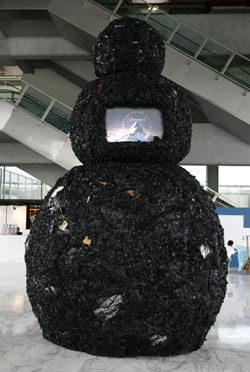

 Since the early 1990s Nari Ward has been one of the most consistently expressive and innovative installation artists working in the U.S., although his work has only become widely known outside the country during the past few years. Favoring room-scale accumulations of mostly found materials, Ward’s fundamental artistic concerns have to do with the many kinds of meanings that are emboded by one’s materials: cultural, economic, and even biographical. These meanings are never neutral or abstract, and much of Ward’s artistry is directed at bringing out those latent meanings within the context of a larger and more all-encompassing structure, whose implicit ties to the materials become clear upon further examination.
Since the early 1990s Nari Ward has been one of the most consistently expressive and innovative installation artists working in the U.S., although his work has only become widely known outside the country during the past few years. Favoring room-scale accumulations of mostly found materials, Ward’s fundamental artistic concerns have to do with the many kinds of meanings that are emboded by one’s materials: cultural, economic, and even biographical. These meanings are never neutral or abstract, and much of Ward’s artistry is directed at bringing out those latent meanings within the context of a larger and more all-encompassing structure, whose implicit ties to the materials become clear upon further examination.
In one of Ward’s best-known installations, Amazing Grace, hundreds of second-hand baby carriages are brought together in what appears to be a ritualized circle, wherein their functional meanings are offset by their quasi-magical presence, which is reinforced by our gradual recognition that each carriage has probably served more than an entire generation of babies, and was probably only discarded once it became absolutely clear that it could no longer function. Vessels of the past and harbingers of the future, Ward’s ring of carriages takes on greater poignancy thanks to its accompanying soundtrack of Mahalia Jackson singing the spiritual Amazing Grace. On a very different occasion – a multi-year collaboration with the choreographer Ralph Lemon – Ward generated a mesmerizing effect by having several hundred empty pint bottles of the very cheapest street booze descend slowly and hypnotically from the ceiling, ending up as a shimmering, multi-colored glass wall.
Ward’s project for Taipei, Black Top Man, consists of a large-scale standing human figure made almost entirely (except for its armature) from the grade of tar normally used to cover streets and highways. The image is unsettlng, if ony because it appears to indirectly reference a Southern folk tale that has all but vanished due to its fairly obvious racist connotation: ‘Brer Rabbit and the Tar Baby,’ in which the enemy fox is defeated by a giant baby made of tar, whose passivity infuriates the animal so much he keeps punching it until he can no longer extricate arms, legs or head. In Ward’s version, the oversized figure looms over us like a neo-primitive icon, its unorthodox surface material underscoring its peculiarly fetishistic presence, as a kind of false idol which makes little effort to pass itself off as the real thing.